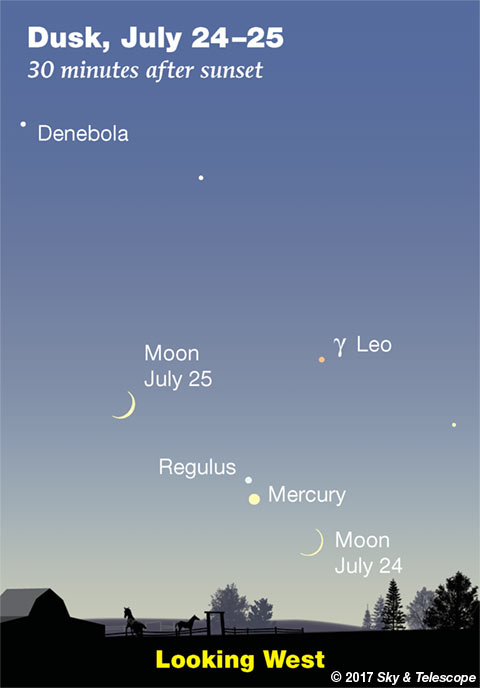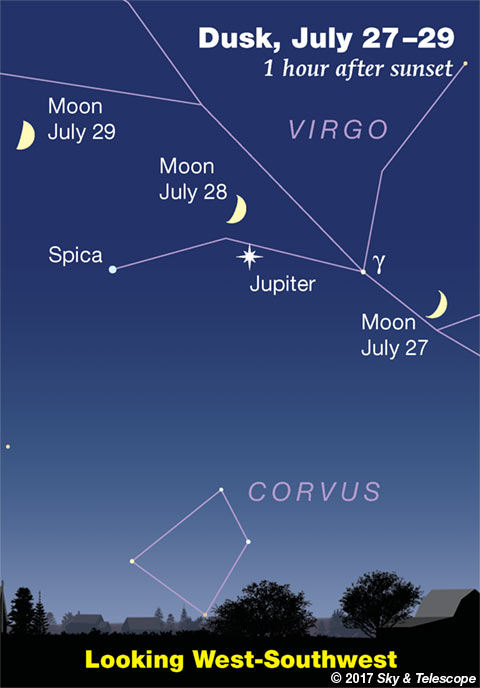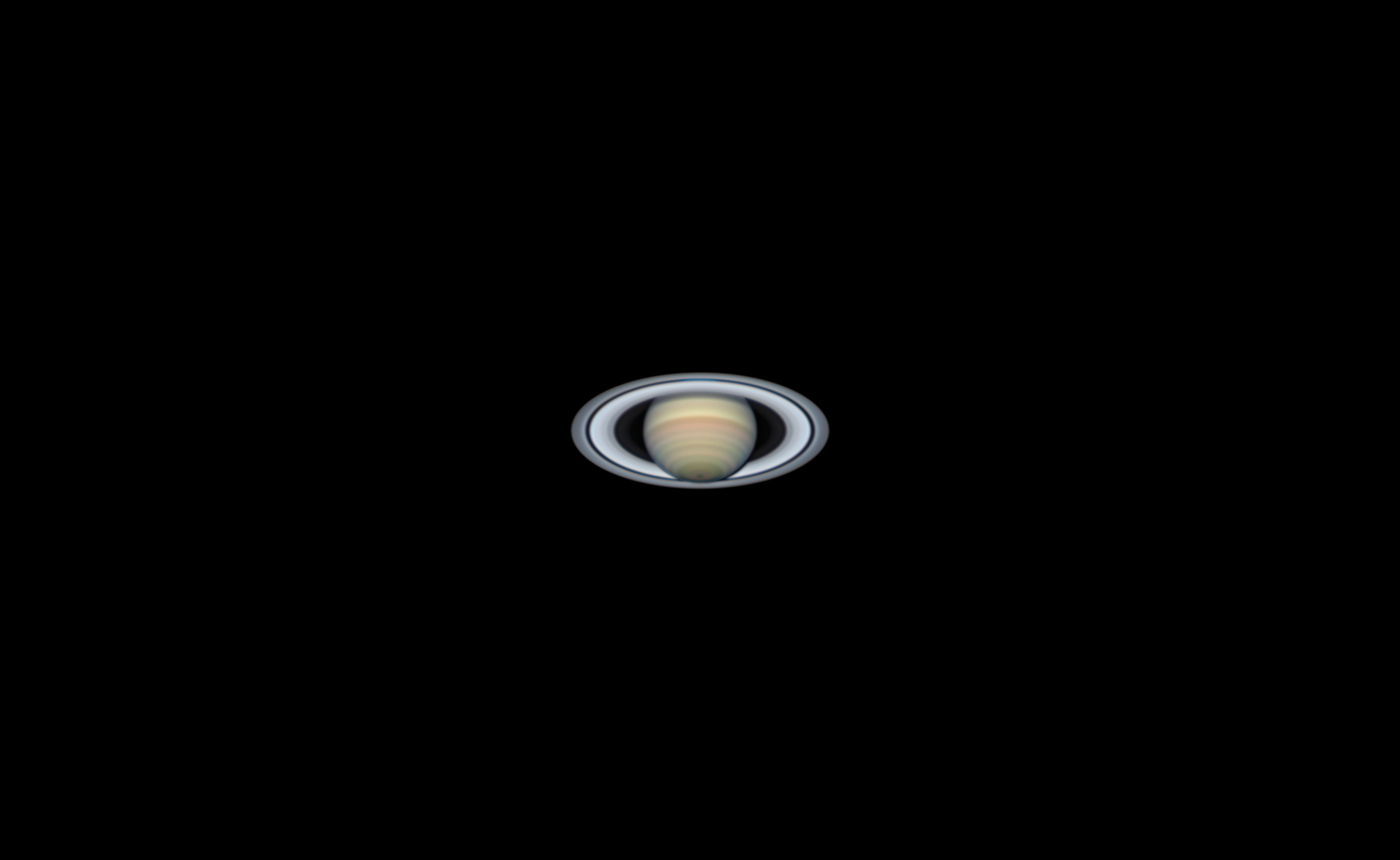Friday, July 21
• We're only a third of the way through summer, but already W-shaped Cassiopeia, a constellation better known for decorating fall and winter evenings, is climbing up in the north-northeast after dark. And the Great Square of Pegasus, icon of fall, comes up to balance on one corner just over the east horizon.
Saturday, July 22
• The Big Dipper, still high in the northwest after dark, is turning around to "scoop up water" through the evenings of summer and early fall.
• Starry Scorpius is sometimes called "the Orion of Summer" for its brightness and its prominent red supergiant (Antares in the case of Scorpius, Betelgeuse for Orion). But Scorpius passes a lot lower in the south than Orion for those of us at mid-northern latitudes. That means Scorpius has only one really good evening month: July.
Catch Scorpius due south right after nightfall, before it starts to tilt lower toward the southwest. It's full of deep-sky objects for binoculars or a telescope — if you have a detailed star atlas to find them with. (See the Pocket Sky Atlas below.)
Sunday, July 23
• The tail of Scorpius curves low to the lower left of the Scorpion's bright head and main body. How low depends on how far north or south you live: the farther south, the higher. Look for the two stars especially close together in the tail. These are Lambda and fainter Upsilon Scorpii, known as the Cat's Eyes. They're canted at an angle; the cat is tilting his head and winking.
The Cat's Eyes point west (right) by nearly a fist-width toward Mu Scorpii, a much tighter pair known as the Little Cat's Eyes. Can you resolve Mu without using binoculars? It takes very sharp vision!
• New Moon (exact at 5:46 a.m. July 23rd EDT).

Monday, July 24
• Using binoculars about 30 minutes after sunset, look very low in the west for Mercury and fainter Regulus with the thin crescent Moon to their lower right, as shown here.
Tuesday, July 25
• Now, in the west in twilight, a thicker, higher crescent moon shines upper left of Mercury and Regulus. The planet and star are in conjunction this evening, with Mercury to Regulus's lower right. (Their orientation in the scene here is for yesterday evening.)
Wednesday, July 26
• If you have a dark enough sky, the Milky Way forms a magnificent arch very high across the whole eastern sky after nightfall is complete. It runs all the way from below Cassiopeia in the north-northeast, up and across Cygnus and the Summer Triangle high in the east under bright Vega, and down past the spout of the Sagittarius Teapot in the south.

Thursday, July 27
• The first "star" you're likely to see coming out after sunset is Jupiter in the southwest. It's about a fist at arm's length left of the Moon this evening, as shown here.
Once you find Jupiter, examine the sky about three fists above it for Arcturus, two magnitudes fainter.
As night deepens, you can see that the Moon forms the right-hand end of a gently curving arc with, to its left, faint Gamma Virginis, Jupiter, and Spica.
Friday, July 28
• Jupiter shines under the Moon this evening, more or less as drawn here (their exact placement will depend on your location).
• The Sagittarius Teapot is in the south after darkness is complete. It's about a fist at arm's length wide, and it's now tilting to pour from its spout on the right. The Teapot will tilt farther and farther, pouring out for the rest of the summer — or for much of the night if you stay out late.
Saturday, July 29
• Lower right of the Moon at dusk, look for Spica. Right of Spica shines brighter Jupiter.
________________________
Want to become a better astronomer? Learn your way around the constellations! They're the key to locating everything fainter and deeper to hunt with binoculars or a telescope.
This is an outdoor nature hobby. For an easy-to-use constellation guide covering the whole evening sky, use the big monthly map in the center of each issue of Sky & Telescope, the essential guide to astronomy.

Once you get a telescope, to put it to good use you'll need a detailed, large-scale sky atlas (set of charts). The basic standard is the Pocket Sky Atlas (in either the original or Jumbo Edition), which shows stars to magnitude 7.6.
Next up is the larger and deeper Sky Atlas 2000.0, plotting stars to magnitude 8.5; nearly three times as many. The next up, once you know your way around, is the even larger Uranometria 2000.0 (stars to magnitude 9.75). And read how to use sky charts with a telescope.
You'll also want a good deep-sky guidebook, such as Sue French's Deep-Sky Wonders collection (which includes its own charts), Sky Atlas 2000.0 Companion by Strong and Sinnott, or the bigger Night Sky Observer's Guide by Kepple and Sanner.
Can a computerized telescope replace charts? Not for beginners, I don't think, and not on mounts and tripods that are less than top-quality mechanically (meaning heavy and expensive). And as Terence Dickinson and Alan Dyer say in their Backyard Astronomer's Guide, "A full appreciation of the universe cannot come without developing the skills to find things in the sky and understanding how the sky works. This knowledge comes only by spending time under the stars with star maps in hand."
This Week's Planet Roundup

South is up. The Cassini Division is visible all around, the outer A Ring and inner B ring brighten toward the division's edge, the dim, innermost C ring is perceptible with effort, and there's no sign of the Encke Gap. On the globe, the bright Equatorial Zone and darker North Equatorial Belt are easy. Click here for the Chilescope team's much larger full-size view (with north up).
Mercury (magnitude 0) is low above the west-northwest horizon 30 or 40 minutes after sunset. Catch it while you can.
Venus (magnitude –4.1) shines brightly in the east before and during dawn. Look for fainter orange Aldebaran increasingly far to its upper right. To Venus's lower right, orange Betelgeuse is rising.
Mars is hidden in conjunction behind the glare of the Sun.
Jupiter (magnitude –1.9, in Virgo) shines brightly in the southwest in early evening. Fainter Spica (magnitude +1.0) glitters 8° or 9° left of it. In a telescope, Jupiter has shrunk to 35 arcseconds wide.
Saturn (magnitude +0.2, in the legs of Ophiuchus) glows steadily in the south at nightfall. Fiery Antares, less bright, twinkles 13° to Saturn's lower right. Delta Scorpii, the third-brightest object in the area, catches the eye about half that far to the upper right of Antares.
Uranus (magnitude 5.8, in Pisces) and Neptune (magnitude 7.9, in Aquarius) are high in the southeast and south, respectively, before dawn begins. Finder charts.
__________________________
All descriptions that relate to your horizon — including the words up, down, right, and left — are written for the world's mid-northern latitudes. Descriptions that also depend on longitude (mainly Moon positions) are for North America.
Eastern Daylight Time (EDT) is Universal Time (UT, UTC, or GMT) minus 4 hours.
__________________________
"This adventure is made possible by generations of searchers strictly adhering to a simple set of rules. Test ideas by experiments and observations. Build on those ideas that pass the test. Reject the ones that fail. Follow the evidence wherever it leads, and question everything. Accept these terms, and the cosmos is yours."
— Neil deGrasse Tyson, 2014
"Objective reality exists. Facts are often determinable. Bacteria evolve in response to antibiotics. Carbon dioxide warms the globe. Science and reason are no political conspiracy. They are how we discover reality. Civilization's survival depends on our ability, and willingness, to do so."
— Alan MacRobert, your Sky at a Glance editor
"Facts are stubborn things; and whatever may be our wishes, our inclinations, or the dictates of our passions, they cannot alter the state of facts and evidence."
— John Adams, 1770
 4
4








Comments
Tom Hoffelder
July 22, 2017 at 7:56 am
I've noticed the 10 degree reference bar has been absent from the all the diagrams showing planet location this month. Perhaps because one of them each week includes Mercury, and there can be quite a difference in that planet's altitude depending on observers' latitudes. For instance, for me in southern Maine (lat 44 deg), Mercury's altitude at 30 minutes after sunset is 5.5 degrees. For someone in southern Florida, it is twice that high. So there is a good reason for not including it in the charts with Mercury, but perhaps the variation could be mentioned for them and the bar included in the other charts in the future. Just an idea. I don't need the reference myself, but thought there might be some who find it useful. On the other hand, you may have discovered that no one uses it.
You must be logged in to post a comment.
Rfousty
July 24, 2017 at 2:07 pm
Yes please use it as reference. I'm new to this wonderful experience.
Bob
You must be logged in to post a comment.
abukh74
July 26, 2017 at 12:14 am
I spotted my first planet on my first observation. She was beautiful. Saturn and her rings.
You must be logged in to post a comment.
mary beth
July 26, 2017 at 11:08 am
That's great! First time I saw it, I couldn't believe how beautiful it is. It looks like something from the Jetsons cartoon lol - too colorful and amazing to be real!
You must be logged in to post a comment.
You must be logged in to post a comment.